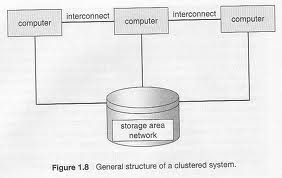Define the essential properties of the following types of operating sys-tems:
- Batch
- Interactive
- Time sharing
- Real time
- Network
- Parallel
- Distributed
- Clustered
- Handheld
ANSWERS:
a. Batch processing:-
Jobs with similar needs are batched together and run through the computer as a group by an operator or automatic job sequencer. Performance is increased by attempting to keep CPU and I/O devices busy at all times through buffering, off-line operation, spooling, and multi-programming. Batch is good for executing large jobs that need little interaction; it can be submitted and picked up later.
b. Interactive System:-
This system is composed of many short transactions where the results of the next transaction may be unpredictable.
Response time needs to be short (seconds) since the user submits and waits for the result.
Response time needs to be short (seconds) since the user submits and waits for the result.
c. Time sharing:-
This systems uses CPU scheduling and multipro-gramming to provide economical interactive use of a system. The CPU switches rapidly from one user to another. Instead of having
a job defined by spooled card images, each program reads its next control card from the terminal, and output is normally printed immediately to the screen.
a job defined by spooled card images, each program reads its next control card from the terminal, and output is normally printed immediately to the screen.
d. Real time operating system:-
Often used in a dedicated application, this system reads information from sensors and must respond within a fixed amount of time to ensure correct performance.
e. Network:-
Provides operating system features across a network such as file sharing.
f. SMP (Symmetric multiprocessing):-
Used in systems where there are multiple CPU’s each running the same copy of the operating system.Communication takes place across the system bus.
g. Distributed systems:-
This system distributes computation among several physical processors. The processors do not share memory or a clock. Instead, each processor has its own local memory. They
communicate with each other through various communication lines, such as a high-speed bus or local area network.
communicate with each other through various communication lines, such as a high-speed bus or local area network.
h. Clustered system:-
A clustered system combines multiple computers into a single system to perform computational task distributed across the cluster.
i. Handheld System:-
A small computer system that performs simple tasks such as calendars, email, and web browsing. Handheld systems differ from traditional desktop systems with smaller memory and
display screens and slower processors.
If you need any more definitions regarding computer systems. Fell free to comment
display screens and slower processors.
If you need any more definitions regarding computer systems. Fell free to comment








Comments
Post a Comment